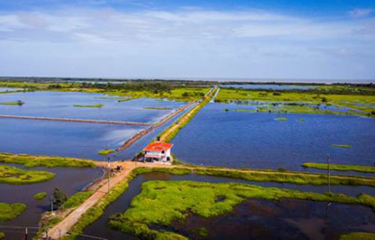Mensburgh Aquaculture is seeking to build an GYD 90.5 million (USD 430,000, EUR 392,000) expansion of its multispecies aquaculture facility in Borlam, Corentyne, Guyana.
The company’s proposal for the 1,000-acre development includes extensive clearing and rehabilitation of brackish-water fish and shrimp ponds, as well as a seafood processing facility, according to a proposal submitted in November 2023 to the Guyana Environmental Protection Agency.
Mensburgh Aquaculture, owned by Erwin Abdulla, has existing operations in the area proposed for development, but the expansion would allow it to boost its production, while the processing facility and access to a nearby airport would give it means to develop, package, and export its products, with a focus on delivering “fresh-on-ice” seafood to the domestic, Caribbean, and U.S. markets. The company said it is awaiting the registration and issuance of trademark certificates from the Guyana Registrar of Commerce so it can commence its export business.
Thanks to recently discovered oil reserves, Guyana – with a population of 800,000 – boasts one of the world’s fastest-growing economies. In its application, Mensburgh Aquaculture cited that growth as a potential boon for the country’s nascent seafood sector.
“With increased activity in the mining, forestry, and other hinterland activities there is greater need for shrimp and fish products whether fresh, frozen, or dried. Any increased production would find a ready market for a high protein and wholesome product,” it said in its application. “Mensburgh Aquaculture is the only farm with its own established export and marketing production chain, utilizing existing approved processing and export infrastructure to supply markets with excellent quality in an efficient manner, maintaining ownership of its product throughout the process.”
Mensburgh Aquaculture’s new ponds would be fed with seedlings and nutrients from ocean-fed canals. Some of its processing byproducts will be used as fertilizer for plants on the farm or incorporated into a feed composition, pelletized, and used for food in the ponds, it said. Its water discharge would be channeled into mangrove areas for filtration before being released via drainage canals into the ocean. The company has designated 140 acres of the proposed development for ecological preservation.
The company plans to grow southern brown shrimp (Farfantepenaeus subtilis), white shrimp (Litopenaeus schmitti), southern pink shrimp (Farfantepenaeus notialis), and northern pink shrimp (Farfantepenaeus duorarum), as well as tarpon (Megalops atlanticus), grey mullet (Mugil cephalus), lebranche mullet (Mugil liza), snook (Centropomus undecimalis), tilapia (Oreochromis niloticus), sheriga crab (Portunus rufiremus), and golden apple snail (Pomacea canaliculate).
“The many different species that occur on the farm contribute to the productive systems, either directly or indirectly,” it said. “The complex interactions between the biodiversity and the non-living components of the farm, such as the soil, water, and air, result in a unique ecology that is essential for the productive aspects of the farm and the quality of the products.”
The company wants its processing facility to serve as a local hub for the region’s seafood sector, and the company plans to purchase seafood products from other farms in the area for processing and export.
Guyana President Irfaan Ali has backed brackish-water aquaculture as a means to boost the country’s seafood sector, which has struggled with diminishing catches, according to a press release from the Guyana Ministry of Aquaculture.
The government has offered financial support, with GUY 743.7 million (USD 3.6 million, EUR 3.2 million) put toward advancing the fisheries and aquaculture subsector, of which GUY 230 million (USD 1.1 million, EUR 1 million) is being put toward rehabilitation of 63 shrimp farms and GUY 200 million (USD 957,000, EUR 870,000) dedicated to developing marine cage fish farming.
“When you examine the numbers, each one of those marine cages can bring in a net value of close to GUY 8 million [USD 38,000, EUR 35,000] annually. And you could pay back for the investments within six months,” Ali said.
The government has also suspended the value-added tax for all seafood industry inputs, including equipment and seedlings.
In 2022, Guyana produced 448,250 kilograms of shrimp worth GUY 764 million (USD 3.7 million, EUR 3.3 million), up 19 percent year over year.
Guyana Agriculture Minister Zulfikar Mustapha said the government has set of goal of 1.5 million kilograms of annual shrimp production by 2025.
“This is in keeping with our goals for the industry, and a testament to the government’s commitment to increasing local production, lowering the food import bill, and increasing both our production and export capacities,” Mustapha said.
The ministry’s plan is based off guidance developed by the United Nations Food and Agriculture Organization, the World Wildlife Fund-Guianas, and the Guyana Fisheries Department. Additionally, the Guyanese government has partnered with the FAO to conduct a study and pilot a strategy to enhance shrimp production in Guyana and several other Caribbean states, according to the Agriculture Ministry.
Photo courtesy of Mensburgh Aquaculture







